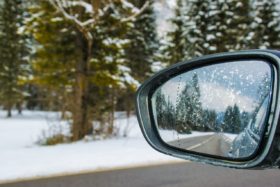Tips for Driving Rear-Wheel Drive Cars in the Snow

When the roads are covered with snow and ice, it’s important to have a car that is up to the challenge. Generally speaking, a rear-wheel drive (RWD) vehicle isn’t the most ideal car for winter driving and the reason for this is because of the way the vehicle is designed. RWD cars have the engine’s weight placed at the front of the vehicle with the drive wheels in the back, which can make cars prone to fishtailing on slippery roads because the reduced weight in the back makes it harder for the rear tires to grip the ground.
While all-wheel and four-wheel drive vehicles have become the norm in recent years, that doesn’t mean they’ve fully disappeared from the roads. According to GM Authority, RWD cars accounted for 9.1% of new car sales in 2020. So if you drive a RWD car, what can you do to protect yourself – and others – on the road?
Add Weight to the Trunk
One of the most effective winter driving tips for RWD cars is to add some extra weight in the trunk so that the back half of the car can better grip the road. Bags of things like sand, dirt, and cat litter are all widely recommended for this purpose. Make sure that any weight you add to the trunk is evenly distributed over the wheels.
Get Winter Tires
Winter tires can also help give rear-wheel drive vehicles a little extra edge in snowy conditions since they perform better in colder temperatures than all-weather tires and provide better grip. If you decide to get winter tires, it’s a good idea to also ask your mechanic to check your car over while it’s in the shop to make sure it’s in good shape for winter driving. This could include a brake check and refilling your windshield wiper fluid.
Watch Your Speed
“Go slow on ice and snow” is one of the most common pieces of winter driving tips for drivers of all types of vehicles – and for good reason. When roads are slippery, cars need extra time to come to a complete stop and speeding also increases a car’s stopping distance, so speeding on snowy roads can be particularly dangerous. Just remember that posted speed limits are the maximum recommended speed under ideal conditions. If roads are snowy or icy or if visibility is limited by other things like rain or fog, driving the posted speed limit may be unsafe given those conditions.
Practice
After several months of warm, sunny summer weather and more moderate weather during the spring and fall, even experienced drivers can feel a bit rusty when they have to readjust to driving in winter weather. Once winter weather starts to return, it’s not a bad idea to head over to an empty parking lot where you can practice some basic driving maneuvers like making turns and stopping your vehicle so that you can remind yourself about how your rear-wheel drive vehicle handles in winter conditions. Or, you could also look for a winter driving class near you where you could work on building your winter driving skills.
Take it Easy
Driving in the snow can be stressful, but it’s important to make you take it easy with your maneuvers. Avoid slamming on your brakes to make sudden stops, be careful when you make turns, and don’t rush to make it through an intersection before the light changes.
Contact a Michigan Car Accident Lawyer
The sad reality is that even if you do everything you should to be a safe, responsible driver, you can still end up becoming the victim of a car accident. If you’ve been injured in a crash, don’t hesitate to contact a car accident lawyer to learn about your legal options. At Goodwin & Scieszka, you’ll be able to speak to a lawyer experienced in handling Michigan car accident and no-fault cases. Contact us today to find out how we can help you.
Image: Pexels / Thomas H






